Business Economics: Market Equilibrium and Economic Stability Analysis
VerifiedAdded on 2020/04/07
|9
|1693
|74
Report
AI Summary
This report delves into the concept of market equilibrium and its role in economic stability, examining both microeconomic and macroeconomic perspectives. It illustrates how equilibrium is achieved through the interplay of supply and demand, highlighting the forces that maintain market balance. The report further explores macroeconomic stability, using the Australian economy as a case study. It analyzes key indicators such as Gross Domestic Product (GDP) and inflation, revealing a generally stable economic environment. The study also discusses the instruments used for stabilization, including automatic and discretionary stabilizers, which the government employs to manage business cycle fluctuations. The analysis underscores the importance of maintaining equilibrium for economic health and stability, providing valuable insights into the dynamics of market economies and the mechanisms used to ensure their resilience.
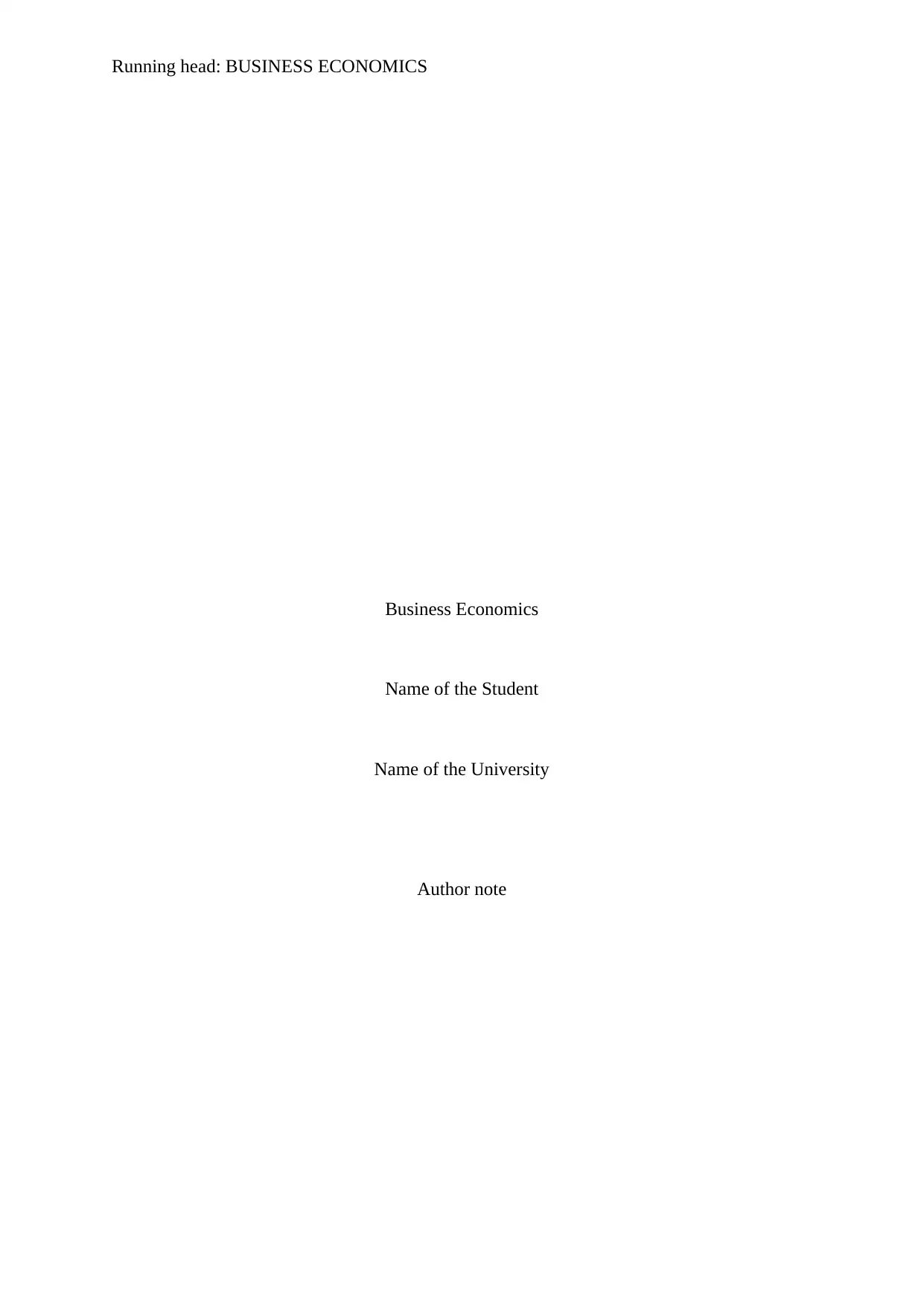
Running head: BUSINESS ECONOMICS
Business Economics
Name of the Student
Name of the University
Author note
Business Economics
Name of the Student
Name of the University
Author note
Paraphrase This Document
Need a fresh take? Get an instant paraphrase of this document with our AI Paraphraser
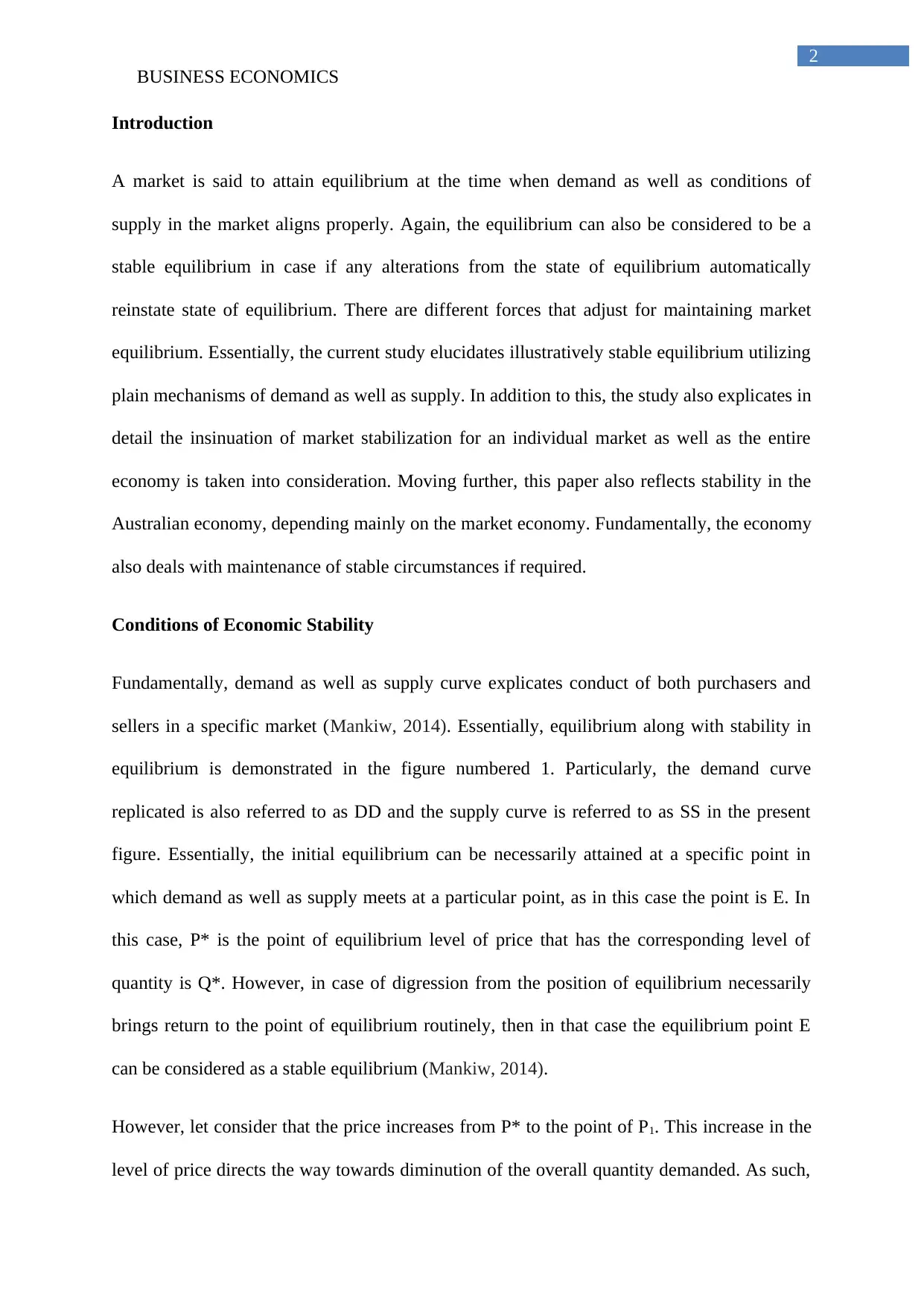
2
BUSINESS ECONOMICS
Introduction
A market is said to attain equilibrium at the time when demand as well as conditions of
supply in the market aligns properly. Again, the equilibrium can also be considered to be a
stable equilibrium in case if any alterations from the state of equilibrium automatically
reinstate state of equilibrium. There are different forces that adjust for maintaining market
equilibrium. Essentially, the current study elucidates illustratively stable equilibrium utilizing
plain mechanisms of demand as well as supply. In addition to this, the study also explicates in
detail the insinuation of market stabilization for an individual market as well as the entire
economy is taken into consideration. Moving further, this paper also reflects stability in the
Australian economy, depending mainly on the market economy. Fundamentally, the economy
also deals with maintenance of stable circumstances if required.
Conditions of Economic Stability
Fundamentally, demand as well as supply curve explicates conduct of both purchasers and
sellers in a specific market (Mankiw, 2014). Essentially, equilibrium along with stability in
equilibrium is demonstrated in the figure numbered 1. Particularly, the demand curve
replicated is also referred to as DD and the supply curve is referred to as SS in the present
figure. Essentially, the initial equilibrium can be necessarily attained at a specific point in
which demand as well as supply meets at a particular point, as in this case the point is E. In
this case, P* is the point of equilibrium level of price that has the corresponding level of
quantity is Q*. However, in case of digression from the position of equilibrium necessarily
brings return to the point of equilibrium routinely, then in that case the equilibrium point E
can be considered as a stable equilibrium (Mankiw, 2014).
However, let consider that the price increases from P* to the point of P1. This increase in the
level of price directs the way towards diminution of the overall quantity demanded. As such,
BUSINESS ECONOMICS
Introduction
A market is said to attain equilibrium at the time when demand as well as conditions of
supply in the market aligns properly. Again, the equilibrium can also be considered to be a
stable equilibrium in case if any alterations from the state of equilibrium automatically
reinstate state of equilibrium. There are different forces that adjust for maintaining market
equilibrium. Essentially, the current study elucidates illustratively stable equilibrium utilizing
plain mechanisms of demand as well as supply. In addition to this, the study also explicates in
detail the insinuation of market stabilization for an individual market as well as the entire
economy is taken into consideration. Moving further, this paper also reflects stability in the
Australian economy, depending mainly on the market economy. Fundamentally, the economy
also deals with maintenance of stable circumstances if required.
Conditions of Economic Stability
Fundamentally, demand as well as supply curve explicates conduct of both purchasers and
sellers in a specific market (Mankiw, 2014). Essentially, equilibrium along with stability in
equilibrium is demonstrated in the figure numbered 1. Particularly, the demand curve
replicated is also referred to as DD and the supply curve is referred to as SS in the present
figure. Essentially, the initial equilibrium can be necessarily attained at a specific point in
which demand as well as supply meets at a particular point, as in this case the point is E. In
this case, P* is the point of equilibrium level of price that has the corresponding level of
quantity is Q*. However, in case of digression from the position of equilibrium necessarily
brings return to the point of equilibrium routinely, then in that case the equilibrium point E
can be considered as a stable equilibrium (Mankiw, 2014).
However, let consider that the price increases from P* to the point of P1. This increase in the
level of price directs the way towards diminution of the overall quantity demanded. As such,
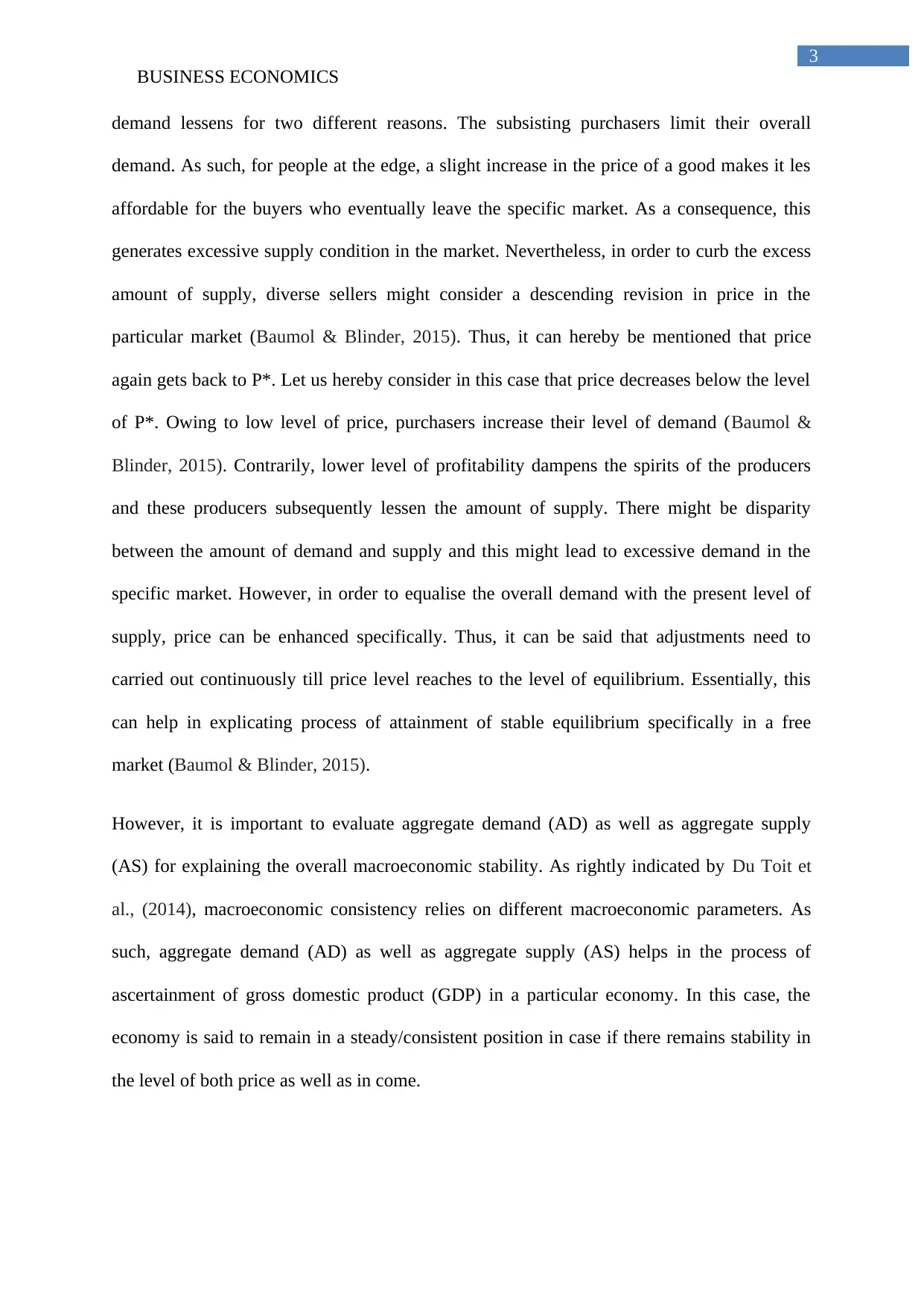
3
BUSINESS ECONOMICS
demand lessens for two different reasons. The subsisting purchasers limit their overall
demand. As such, for people at the edge, a slight increase in the price of a good makes it les
affordable for the buyers who eventually leave the specific market. As a consequence, this
generates excessive supply condition in the market. Nevertheless, in order to curb the excess
amount of supply, diverse sellers might consider a descending revision in price in the
particular market (Baumol & Blinder, 2015). Thus, it can hereby be mentioned that price
again gets back to P*. Let us hereby consider in this case that price decreases below the level
of P*. Owing to low level of price, purchasers increase their level of demand (Baumol &
Blinder, 2015). Contrarily, lower level of profitability dampens the spirits of the producers
and these producers subsequently lessen the amount of supply. There might be disparity
between the amount of demand and supply and this might lead to excessive demand in the
specific market. However, in order to equalise the overall demand with the present level of
supply, price can be enhanced specifically. Thus, it can be said that adjustments need to
carried out continuously till price level reaches to the level of equilibrium. Essentially, this
can help in explicating process of attainment of stable equilibrium specifically in a free
market (Baumol & Blinder, 2015).
However, it is important to evaluate aggregate demand (AD) as well as aggregate supply
(AS) for explaining the overall macroeconomic stability. As rightly indicated by Du Toit et
al., (2014), macroeconomic consistency relies on different macroeconomic parameters. As
such, aggregate demand (AD) as well as aggregate supply (AS) helps in the process of
ascertainment of gross domestic product (GDP) in a particular economy. In this case, the
economy is said to remain in a steady/consistent position in case if there remains stability in
the level of both price as well as in come.
BUSINESS ECONOMICS
demand lessens for two different reasons. The subsisting purchasers limit their overall
demand. As such, for people at the edge, a slight increase in the price of a good makes it les
affordable for the buyers who eventually leave the specific market. As a consequence, this
generates excessive supply condition in the market. Nevertheless, in order to curb the excess
amount of supply, diverse sellers might consider a descending revision in price in the
particular market (Baumol & Blinder, 2015). Thus, it can hereby be mentioned that price
again gets back to P*. Let us hereby consider in this case that price decreases below the level
of P*. Owing to low level of price, purchasers increase their level of demand (Baumol &
Blinder, 2015). Contrarily, lower level of profitability dampens the spirits of the producers
and these producers subsequently lessen the amount of supply. There might be disparity
between the amount of demand and supply and this might lead to excessive demand in the
specific market. However, in order to equalise the overall demand with the present level of
supply, price can be enhanced specifically. Thus, it can be said that adjustments need to
carried out continuously till price level reaches to the level of equilibrium. Essentially, this
can help in explicating process of attainment of stable equilibrium specifically in a free
market (Baumol & Blinder, 2015).
However, it is important to evaluate aggregate demand (AD) as well as aggregate supply
(AS) for explaining the overall macroeconomic stability. As rightly indicated by Du Toit et
al., (2014), macroeconomic consistency relies on different macroeconomic parameters. As
such, aggregate demand (AD) as well as aggregate supply (AS) helps in the process of
ascertainment of gross domestic product (GDP) in a particular economy. In this case, the
economy is said to remain in a steady/consistent position in case if there remains stability in
the level of both price as well as in come.
⊘ This is a preview!⊘
Do you want full access?
Subscribe today to unlock all pages.

Trusted by 1+ million students worldwide
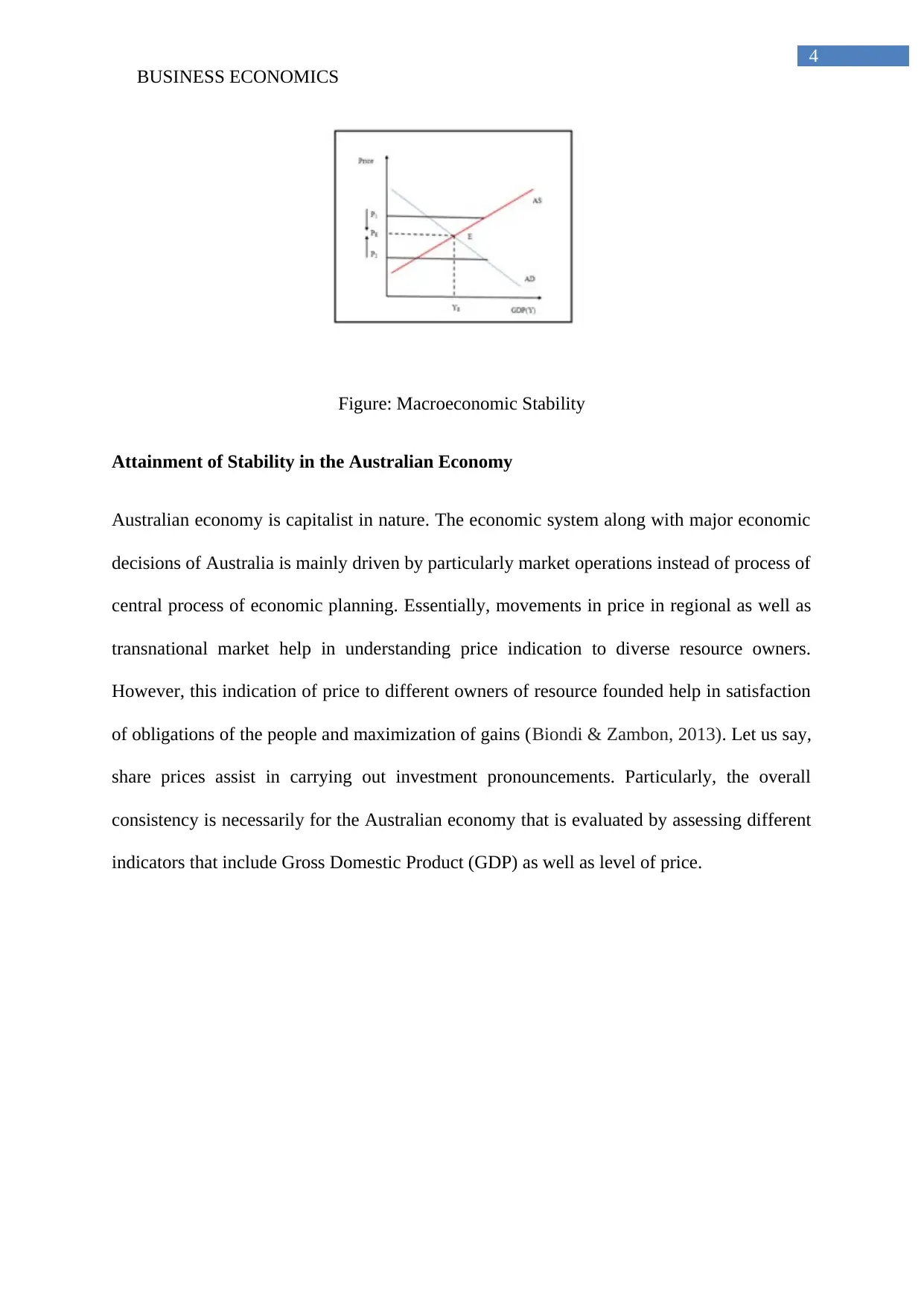
4
BUSINESS ECONOMICS
Figure: Macroeconomic Stability
Attainment of Stability in the Australian Economy
Australian economy is capitalist in nature. The economic system along with major economic
decisions of Australia is mainly driven by particularly market operations instead of process of
central process of economic planning. Essentially, movements in price in regional as well as
transnational market help in understanding price indication to diverse resource owners.
However, this indication of price to different owners of resource founded help in satisfaction
of obligations of the people and maximization of gains (Biondi & Zambon, 2013). Let us say,
share prices assist in carrying out investment pronouncements. Particularly, the overall
consistency is necessarily for the Australian economy that is evaluated by assessing different
indicators that include Gross Domestic Product (GDP) as well as level of price.
BUSINESS ECONOMICS
Figure: Macroeconomic Stability
Attainment of Stability in the Australian Economy
Australian economy is capitalist in nature. The economic system along with major economic
decisions of Australia is mainly driven by particularly market operations instead of process of
central process of economic planning. Essentially, movements in price in regional as well as
transnational market help in understanding price indication to diverse resource owners.
However, this indication of price to different owners of resource founded help in satisfaction
of obligations of the people and maximization of gains (Biondi & Zambon, 2013). Let us say,
share prices assist in carrying out investment pronouncements. Particularly, the overall
consistency is necessarily for the Australian economy that is evaluated by assessing different
indicators that include Gross Domestic Product (GDP) as well as level of price.
Paraphrase This Document
Need a fresh take? Get an instant paraphrase of this document with our AI Paraphraser
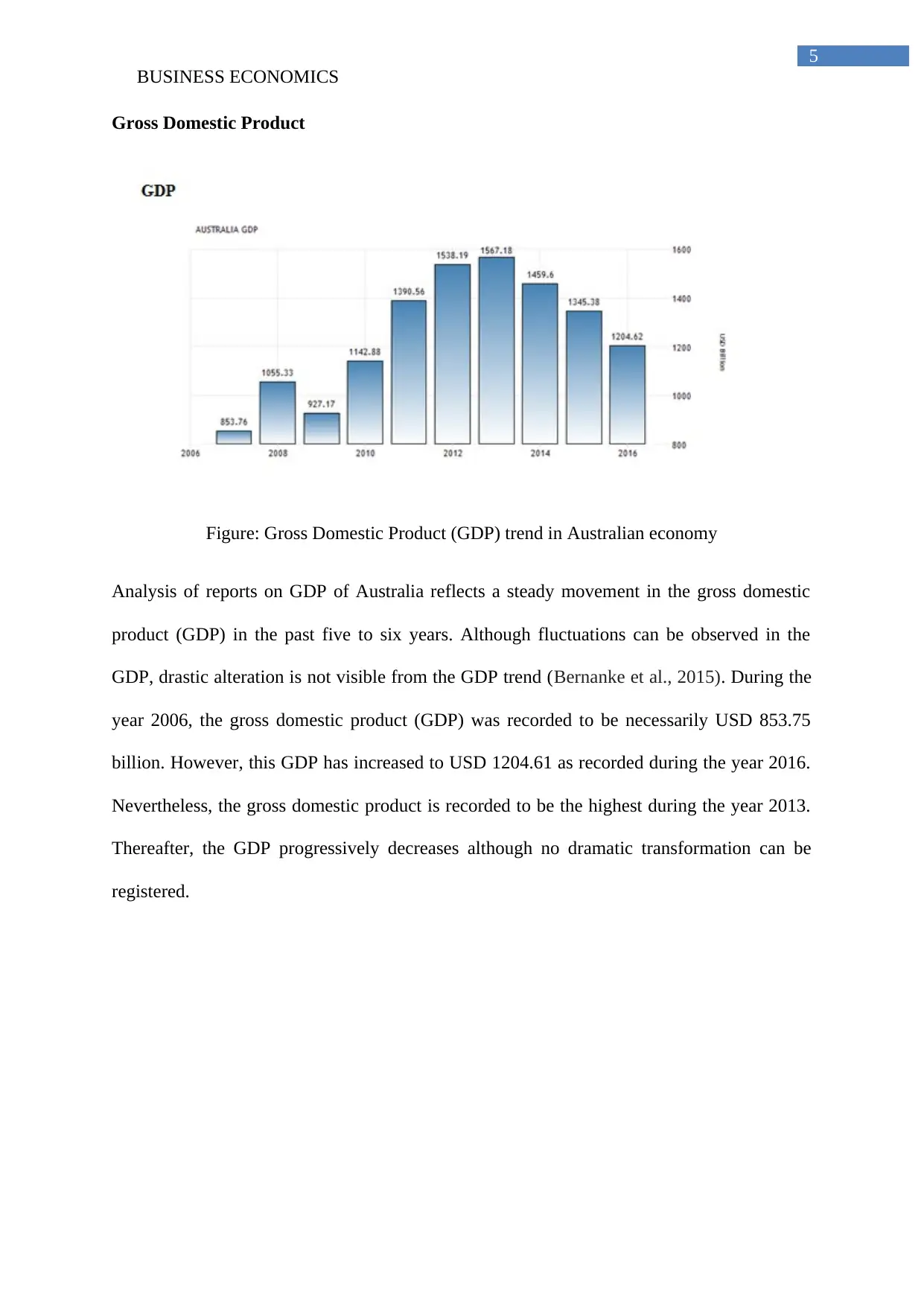
5
BUSINESS ECONOMICS
Gross Domestic Product
Figure: Gross Domestic Product (GDP) trend in Australian economy
Analysis of reports on GDP of Australia reflects a steady movement in the gross domestic
product (GDP) in the past five to six years. Although fluctuations can be observed in the
GDP, drastic alteration is not visible from the GDP trend (Bernanke et al., 2015). During the
year 2006, the gross domestic product (GDP) was recorded to be necessarily USD 853.75
billion. However, this GDP has increased to USD 1204.61 as recorded during the year 2016.
Nevertheless, the gross domestic product is recorded to be the highest during the year 2013.
Thereafter, the GDP progressively decreases although no dramatic transformation can be
registered.
BUSINESS ECONOMICS
Gross Domestic Product
Figure: Gross Domestic Product (GDP) trend in Australian economy
Analysis of reports on GDP of Australia reflects a steady movement in the gross domestic
product (GDP) in the past five to six years. Although fluctuations can be observed in the
GDP, drastic alteration is not visible from the GDP trend (Bernanke et al., 2015). During the
year 2006, the gross domestic product (GDP) was recorded to be necessarily USD 853.75
billion. However, this GDP has increased to USD 1204.61 as recorded during the year 2016.
Nevertheless, the gross domestic product is recorded to be the highest during the year 2013.
Thereafter, the GDP progressively decreases although no dramatic transformation can be
registered.
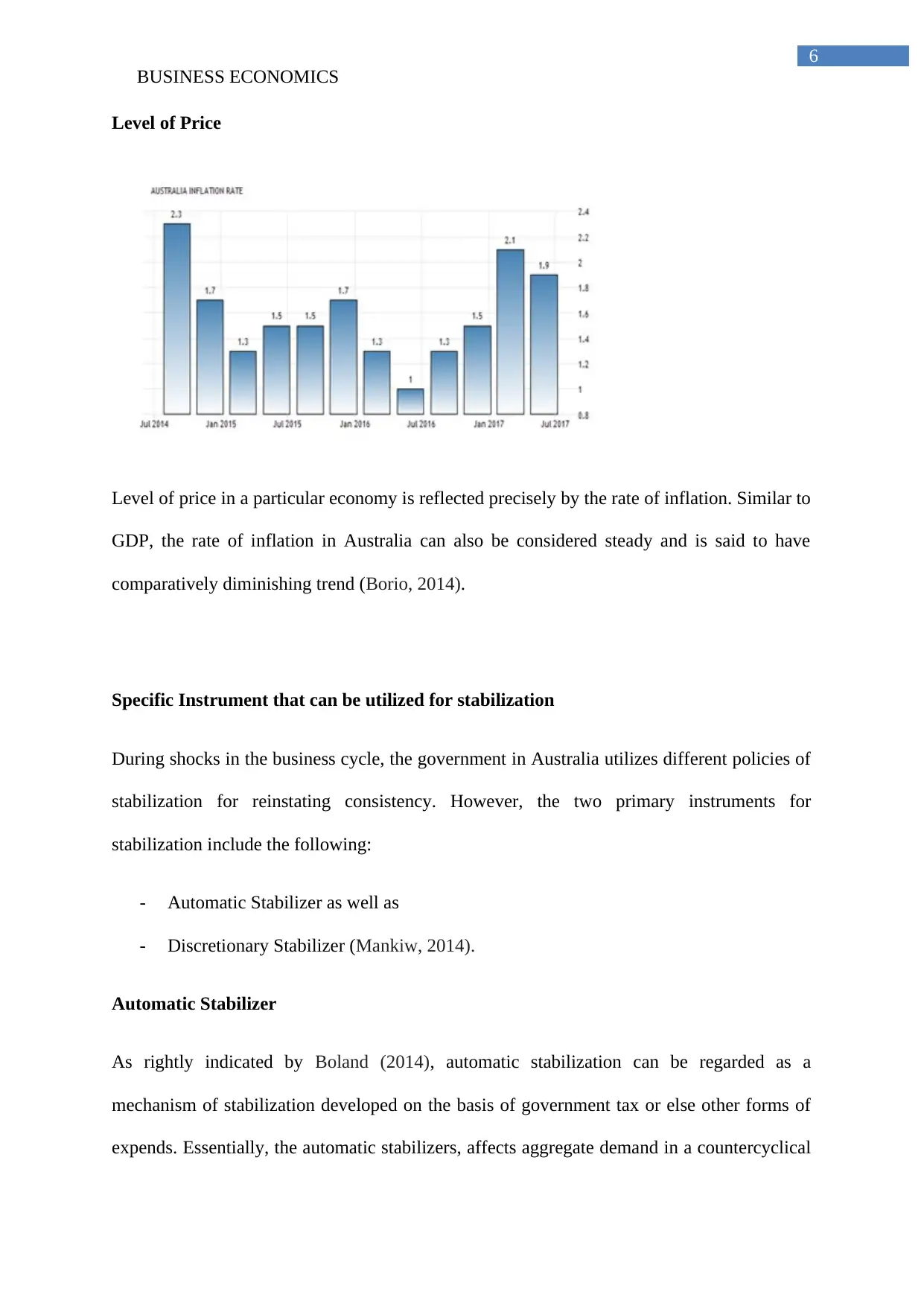
6
BUSINESS ECONOMICS
Level of Price
Level of price in a particular economy is reflected precisely by the rate of inflation. Similar to
GDP, the rate of inflation in Australia can also be considered steady and is said to have
comparatively diminishing trend (Borio, 2014).
Specific Instrument that can be utilized for stabilization
During shocks in the business cycle, the government in Australia utilizes different policies of
stabilization for reinstating consistency. However, the two primary instruments for
stabilization include the following:
- Automatic Stabilizer as well as
- Discretionary Stabilizer (Mankiw, 2014).
Automatic Stabilizer
As rightly indicated by Boland (2014), automatic stabilization can be regarded as a
mechanism of stabilization developed on the basis of government tax or else other forms of
expends. Essentially, the automatic stabilizers, affects aggregate demand in a countercyclical
BUSINESS ECONOMICS
Level of Price
Level of price in a particular economy is reflected precisely by the rate of inflation. Similar to
GDP, the rate of inflation in Australia can also be considered steady and is said to have
comparatively diminishing trend (Borio, 2014).
Specific Instrument that can be utilized for stabilization
During shocks in the business cycle, the government in Australia utilizes different policies of
stabilization for reinstating consistency. However, the two primary instruments for
stabilization include the following:
- Automatic Stabilizer as well as
- Discretionary Stabilizer (Mankiw, 2014).
Automatic Stabilizer
As rightly indicated by Boland (2014), automatic stabilization can be regarded as a
mechanism of stabilization developed on the basis of government tax or else other forms of
expends. Essentially, the automatic stabilizers, affects aggregate demand in a countercyclical
⊘ This is a preview!⊘
Do you want full access?
Subscribe today to unlock all pages.

Trusted by 1+ million students worldwide
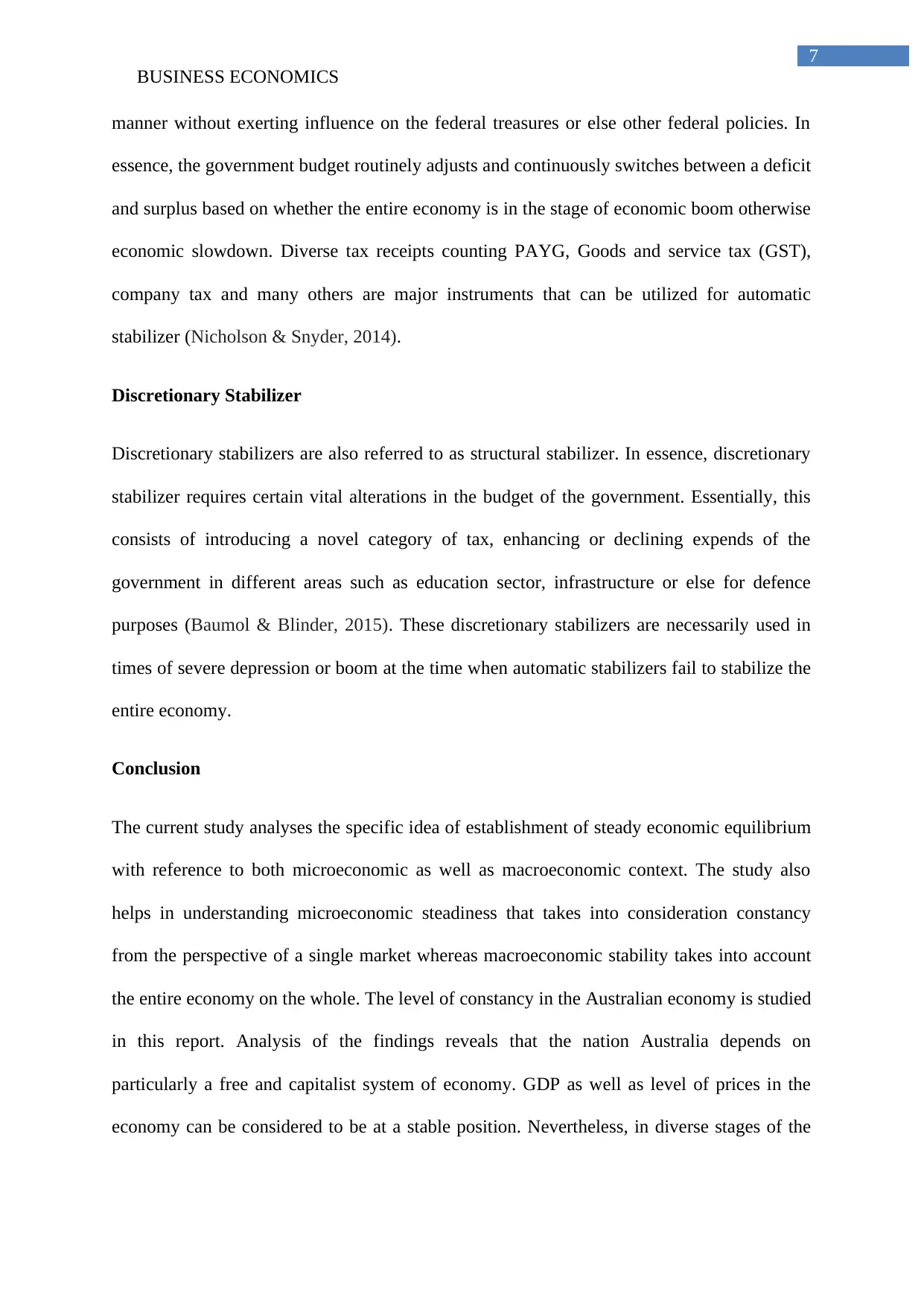
7
BUSINESS ECONOMICS
manner without exerting influence on the federal treasures or else other federal policies. In
essence, the government budget routinely adjusts and continuously switches between a deficit
and surplus based on whether the entire economy is in the stage of economic boom otherwise
economic slowdown. Diverse tax receipts counting PAYG, Goods and service tax (GST),
company tax and many others are major instruments that can be utilized for automatic
stabilizer (Nicholson & Snyder, 2014).
Discretionary Stabilizer
Discretionary stabilizers are also referred to as structural stabilizer. In essence, discretionary
stabilizer requires certain vital alterations in the budget of the government. Essentially, this
consists of introducing a novel category of tax, enhancing or declining expends of the
government in different areas such as education sector, infrastructure or else for defence
purposes (Baumol & Blinder, 2015). These discretionary stabilizers are necessarily used in
times of severe depression or boom at the time when automatic stabilizers fail to stabilize the
entire economy.
Conclusion
The current study analyses the specific idea of establishment of steady economic equilibrium
with reference to both microeconomic as well as macroeconomic context. The study also
helps in understanding microeconomic steadiness that takes into consideration constancy
from the perspective of a single market whereas macroeconomic stability takes into account
the entire economy on the whole. The level of constancy in the Australian economy is studied
in this report. Analysis of the findings reveals that the nation Australia depends on
particularly a free and capitalist system of economy. GDP as well as level of prices in the
economy can be considered to be at a stable position. Nevertheless, in diverse stages of the
BUSINESS ECONOMICS
manner without exerting influence on the federal treasures or else other federal policies. In
essence, the government budget routinely adjusts and continuously switches between a deficit
and surplus based on whether the entire economy is in the stage of economic boom otherwise
economic slowdown. Diverse tax receipts counting PAYG, Goods and service tax (GST),
company tax and many others are major instruments that can be utilized for automatic
stabilizer (Nicholson & Snyder, 2014).
Discretionary Stabilizer
Discretionary stabilizers are also referred to as structural stabilizer. In essence, discretionary
stabilizer requires certain vital alterations in the budget of the government. Essentially, this
consists of introducing a novel category of tax, enhancing or declining expends of the
government in different areas such as education sector, infrastructure or else for defence
purposes (Baumol & Blinder, 2015). These discretionary stabilizers are necessarily used in
times of severe depression or boom at the time when automatic stabilizers fail to stabilize the
entire economy.
Conclusion
The current study analyses the specific idea of establishment of steady economic equilibrium
with reference to both microeconomic as well as macroeconomic context. The study also
helps in understanding microeconomic steadiness that takes into consideration constancy
from the perspective of a single market whereas macroeconomic stability takes into account
the entire economy on the whole. The level of constancy in the Australian economy is studied
in this report. Analysis of the findings reveals that the nation Australia depends on
particularly a free and capitalist system of economy. GDP as well as level of prices in the
economy can be considered to be at a stable position. Nevertheless, in diverse stages of the
Paraphrase This Document
Need a fresh take? Get an instant paraphrase of this document with our AI Paraphraser
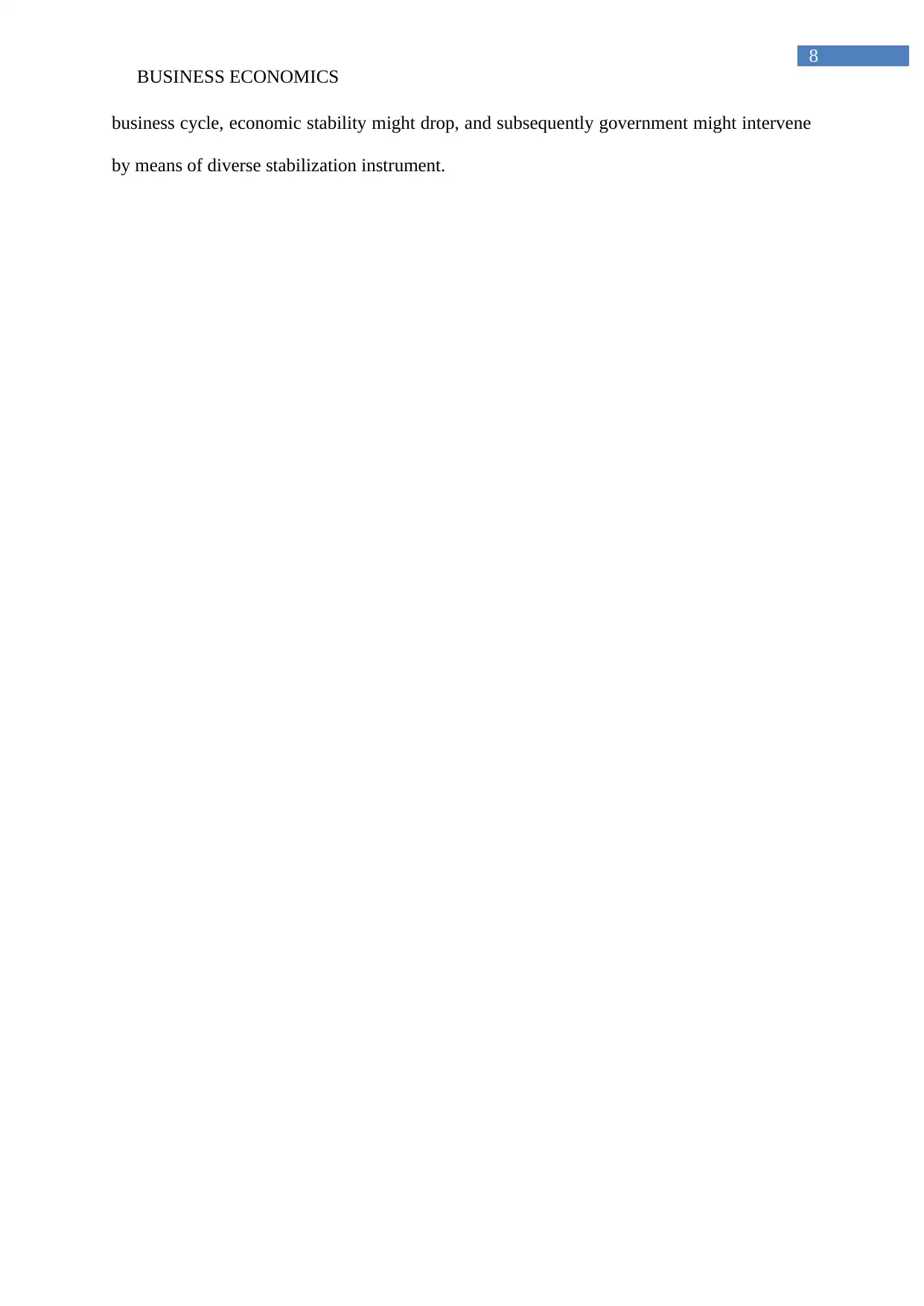
8
BUSINESS ECONOMICS
business cycle, economic stability might drop, and subsequently government might intervene
by means of diverse stabilization instrument.
BUSINESS ECONOMICS
business cycle, economic stability might drop, and subsequently government might intervene
by means of diverse stabilization instrument.
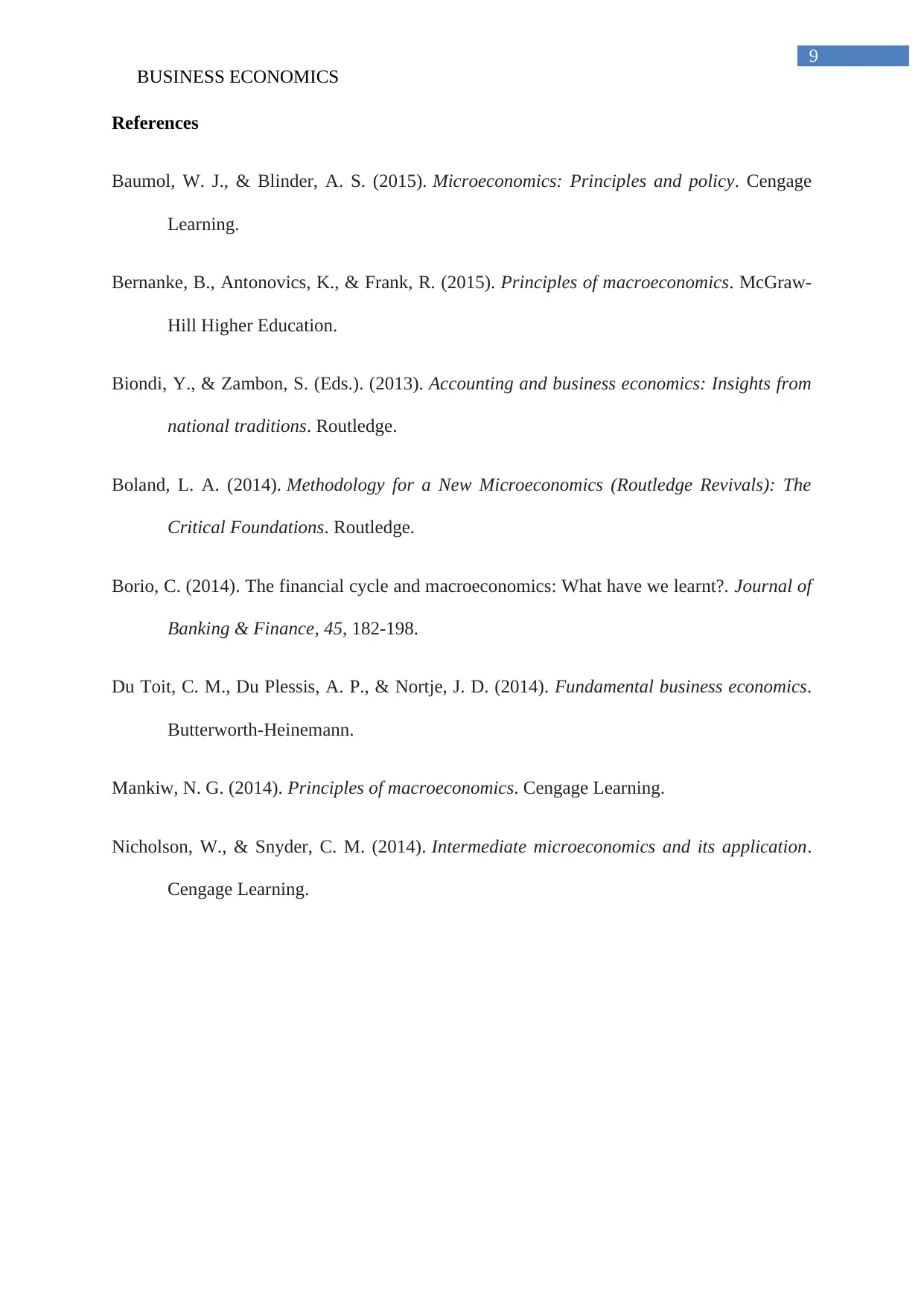
9
BUSINESS ECONOMICS
References
Baumol, W. J., & Blinder, A. S. (2015). Microeconomics: Principles and policy. Cengage
Learning.
Bernanke, B., Antonovics, K., & Frank, R. (2015). Principles of macroeconomics. McGraw-
Hill Higher Education.
Biondi, Y., & Zambon, S. (Eds.). (2013). Accounting and business economics: Insights from
national traditions. Routledge.
Boland, L. A. (2014). Methodology for a New Microeconomics (Routledge Revivals): The
Critical Foundations. Routledge.
Borio, C. (2014). The financial cycle and macroeconomics: What have we learnt?. Journal of
Banking & Finance, 45, 182-198.
Du Toit, C. M., Du Plessis, A. P., & Nortje, J. D. (2014). Fundamental business economics.
Butterworth-Heinemann.
Mankiw, N. G. (2014). Principles of macroeconomics. Cengage Learning.
Nicholson, W., & Snyder, C. M. (2014). Intermediate microeconomics and its application.
Cengage Learning.
BUSINESS ECONOMICS
References
Baumol, W. J., & Blinder, A. S. (2015). Microeconomics: Principles and policy. Cengage
Learning.
Bernanke, B., Antonovics, K., & Frank, R. (2015). Principles of macroeconomics. McGraw-
Hill Higher Education.
Biondi, Y., & Zambon, S. (Eds.). (2013). Accounting and business economics: Insights from
national traditions. Routledge.
Boland, L. A. (2014). Methodology for a New Microeconomics (Routledge Revivals): The
Critical Foundations. Routledge.
Borio, C. (2014). The financial cycle and macroeconomics: What have we learnt?. Journal of
Banking & Finance, 45, 182-198.
Du Toit, C. M., Du Plessis, A. P., & Nortje, J. D. (2014). Fundamental business economics.
Butterworth-Heinemann.
Mankiw, N. G. (2014). Principles of macroeconomics. Cengage Learning.
Nicholson, W., & Snyder, C. M. (2014). Intermediate microeconomics and its application.
Cengage Learning.
⊘ This is a preview!⊘
Do you want full access?
Subscribe today to unlock all pages.

Trusted by 1+ million students worldwide
1 out of 9
Related Documents
Your All-in-One AI-Powered Toolkit for Academic Success.
+13062052269
info@desklib.com
Available 24*7 on WhatsApp / Email
![[object Object]](/_next/static/media/star-bottom.7253800d.svg)
Unlock your academic potential
Copyright © 2020–2025 A2Z Services. All Rights Reserved. Developed and managed by ZUCOL.





